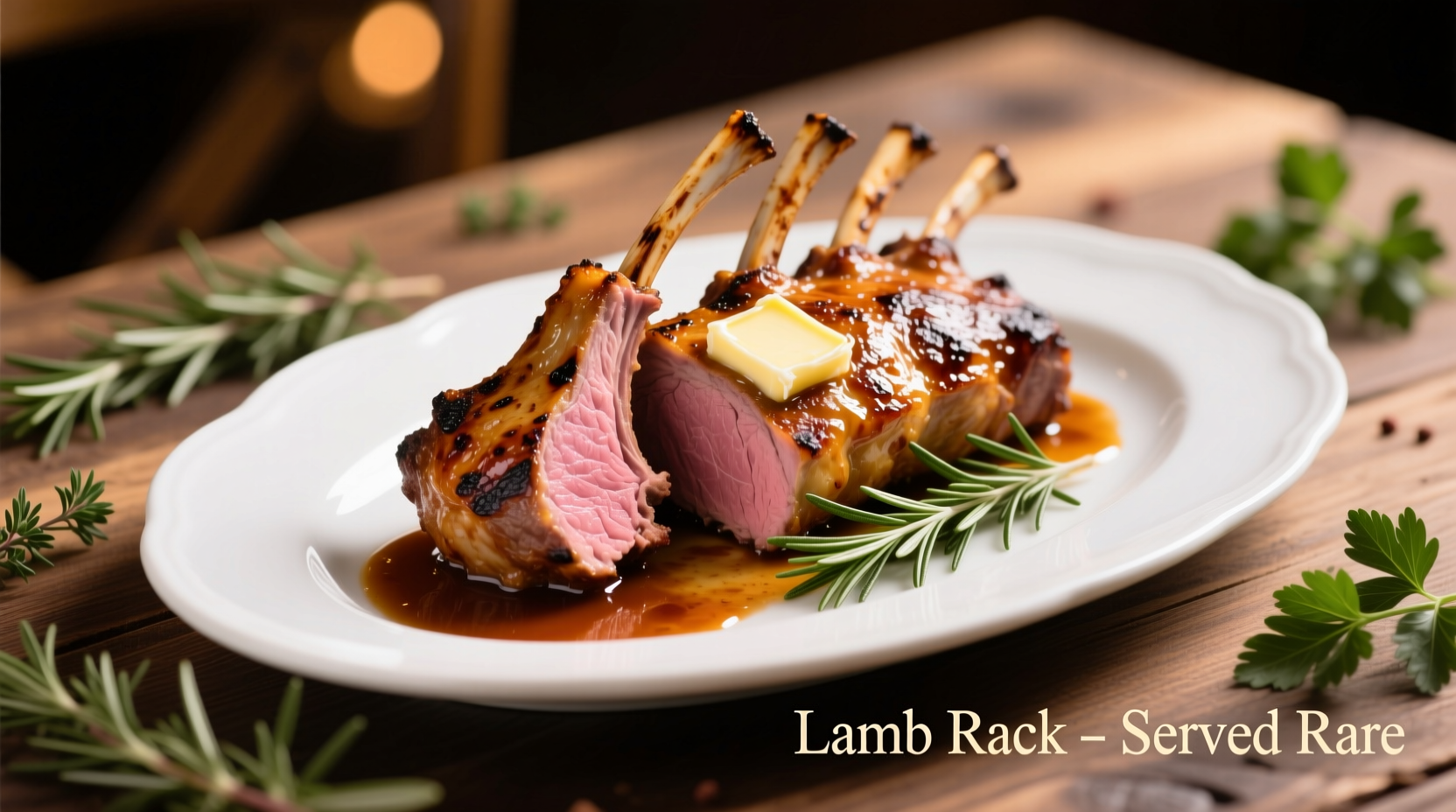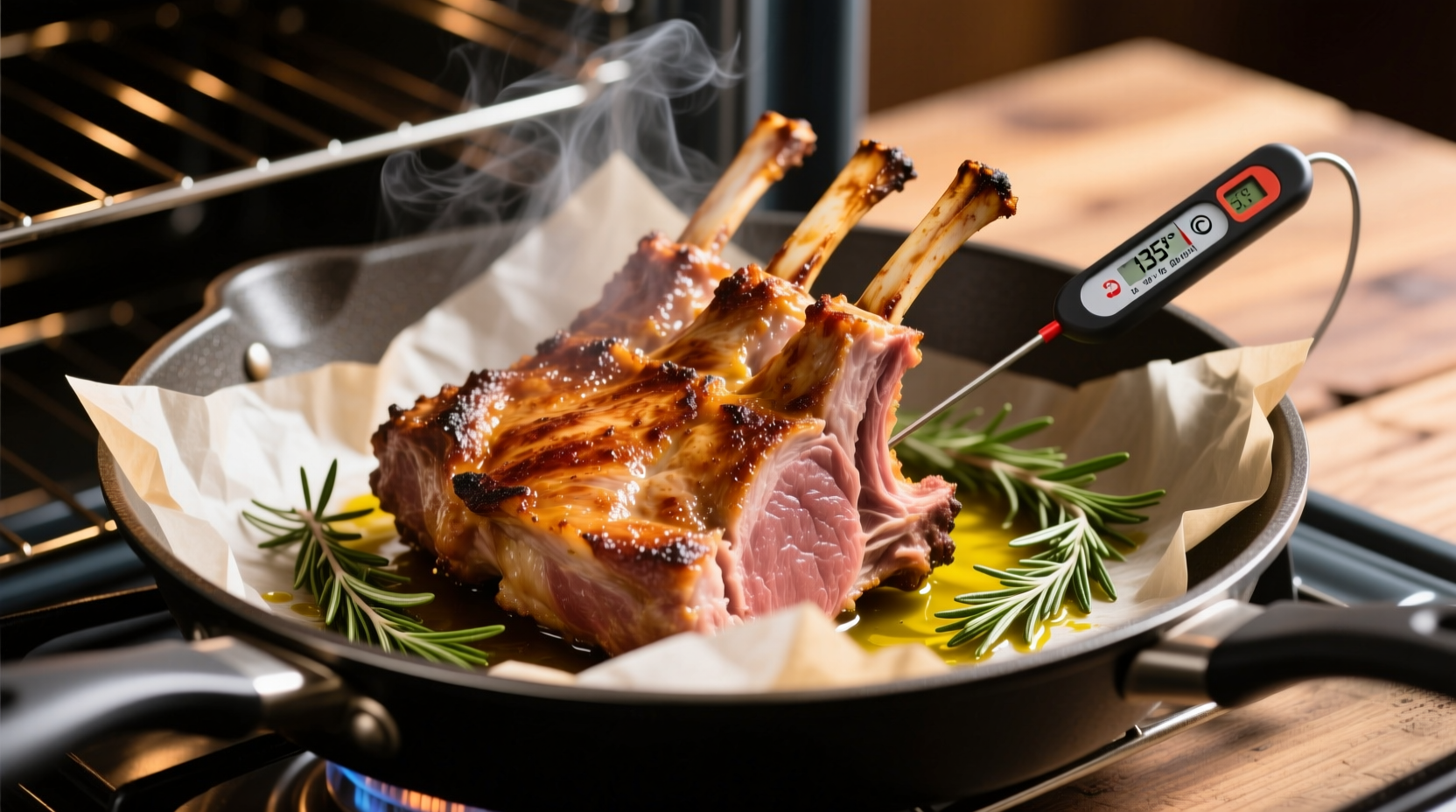The ideal cooking time for a standard 1.5-2 lb rack of lamb in a preheated 375°F (190°C) oven is 20-25 minutes for medium-rare doneness. For precise results, use a meat thermometer to check internal temperature: 125°F (52°C) for rare, 135°F (57°C) for medium-rare, and 145°F (63°C) for medium. Always allow 10-15 minutes of resting time before serving.
| Doneness Level | Internal Temperature | Cooking Time (1.5-2 lb rack) |
|---|---|---|
| Rare | 120-125°F (49-52°C) | 18-22 minutes |
| Medium-Rare | 130-135°F (54-57°C) | 20-25 minutes |
| Medium | 140-145°F (60-63°C) | 25-30 minutes |
The Science Behind Perfectly Cooked Rack of Lamb
Understanding the cooking process for rack of lamb goes beyond simple timing. When you place lamb in the oven, several critical processes occur simultaneously. As protein fibers contract with heat, moisture is expelled from the meat. The key to tender, juicy lamb is stopping the cooking process just before the meat reaches your desired internal temperature, as carryover cooking will continue raising the temperature during resting.
According to the USDA Food Safety and Inspection Service, lamb should reach a minimum internal temperature of 145°F (63°C) for safe consumption, followed by a 3-minute rest time. However, culinary professionals often recommend lower temperatures for optimal texture and flavor, particularly for premium cuts like rack of lamb where quality justifies slightly lower temperatures. USDA guidelines note that whole-muscle cuts like rack of lamb are generally safe at lower temperatures than ground meats.
Your Step-by-Step Rack of Lamb Cooking Process
Preparation Phase: Setting Up for Success
Before your rack of lamb ever touches the oven, proper preparation makes all the difference. Remove the lamb from refrigeration 30-45 minutes before cooking to bring it closer to room temperature—this promotes even cooking. While many recipes call for Frenching (trimming the fat and meat from the bones), this is primarily for presentation and doesn't affect cooking time.
Season generously with salt, pepper, and your choice of herbs. For classic preparation, create a paste of minced garlic, fresh rosemary, and Dijon mustard. The salt begins breaking down muscle fibers immediately, helping retain moisture during cooking. Professional chefs at the Culinary Institute of America emphasize that proper seasoning timing significantly impacts final texture and flavor development.
Oven Setup: Creating the Ideal Cooking Environment
Preheat your oven to 375°F (190°C) for conventional ovens. If using a convection oven, reduce the temperature by 25°F (15°C) as circulating air cooks food faster. Position the oven rack in the center position for even heat distribution.
Place the seasoned rack of lamb on a roasting pan fitted with a wire rack. The elevated position allows hot air to circulate completely around the meat, promoting even browning. For accurate timing, insert an oven-safe meat thermometer into the thickest part of the meat, avoiding the bone. This eliminates guesswork and ensures perfect doneness every time.
Cooking Timeline: Monitoring Your Lamb's Progress
Place the lamb in the preheated oven and set your timer. For a standard 1.5-2 lb rack:
- Rare (120-125°F): Check at 18 minutes
- Medium-rare (130-135°F): Check at 20 minutes
- Medium (140-145°F): Check at 25 minutes
As your lamb approaches target temperature, check the thermometer every 2-3 minutes. Remember that temperature will continue rising 5-10 degrees during resting. When the thermometer reads 5 degrees below your target temperature, remove the lamb from the oven.
Resting and Serving: The Critical Final Step
Transfer the cooked rack of lamb to a cutting board and tent loosely with foil. Allow it to rest for 10-15 minutes. During this crucial phase, internal temperature stabilizes while juices redistribute throughout the meat. Cutting too soon causes valuable juices to escape onto your cutting board rather than remaining in the meat.
For perfect presentation, slice between the bones to create individual chops. Serve immediately with your preferred sides. The resting period ensures each bite delivers maximum tenderness and flavor—skipping this step is the most common mistake home cooks make with premium cuts like rack of lamb.

Troubleshooting Common Rack of Lamb Issues
When Timing Goes Wrong: Recovery Strategies
Even with careful monitoring, sometimes things don't go as planned. If your lamb reaches target temperature faster than expected, immediately transfer it to a wire rack away from the hot pan to slow cooking. If it's undercooked but past the ideal timing window, return it to a slightly cooler oven (325°F/163°C) rather than continuing at high heat, which would overcook the exterior while the interior catches up.
Uneven cooking often occurs when the rack isn't positioned properly in the oven or when the meat wasn't brought to room temperature before cooking. For future attempts, ensure the rack sits horizontally on the wire rack with bones pointing toward the oven's heat source for more consistent results.
Adapting for Different Cooking Scenarios
Convection vs. Conventional Oven Adjustments
Convection ovens circulate hot air, cooking food approximately 25% faster than conventional ovens. When using a convection setting:
- Reduce oven temperature by 25°F (15°C)
- Decrease cooking time by 15-20%
- Monitor temperature 5 minutes earlier than standard timing
Professional chefs at America's Test Kitchen found that convection ovens produce superior browning on rack of lamb but require careful monitoring to prevent overcooking the delicate meat.
Adjusting for Rack Size and Thickness
The standard timing applies to 1.5-2 lb racks. For larger or thicker cuts:
- Add 3-5 minutes per additional pound
- For very thick racks (over 2.5 inches), consider starting at 425°F (218°C) for 10 minutes, then reducing to 350°F (177°C)
- Always rely on internal temperature rather than time alone
Context matters significantly here—these guidelines assume standard oven calibration and typical rack thickness. Factors like oven hot spots, starting temperature of the meat, and even rack position can affect cooking time by several minutes. This is why temperature monitoring trumps strict timing for precision cooking.
Perfect Pairings and Finishing Touches
While the cooking process determines texture and safety, finishing touches elevate your rack of lamb to restaurant quality. A simple pan sauce made from the roasting juices, deglazed with red wine or stock and finished with cold butter, adds richness that complements the meat's natural flavors.
Classic accompaniments include roasted root vegetables, mint jelly, or a gremolata of lemon zest, garlic, and parsley. For wine pairings, medium-bodied reds like Pinot Noir or lighter Cabernet Sauvignon work beautifully with medium-rare lamb, enhancing rather than overwhelming the delicate flavor.
Frequently Asked Questions
How do I know when rack of lamb is done without a thermometer?
Without a thermometer, use the touch test: press the meat gently. Rare feels like the base of your thumb when touching your index finger to thumb; medium-rare resembles the feel when touching middle finger to thumb; medium feels like ring finger to thumb. However, a thermometer remains the most reliable method for precision cooking.
Should I sear rack of lamb before roasting?
Searing creates a flavorful crust through the Maillard reaction. For best results, sear all sides in a hot skillet with oil for 1-2 minutes per side before transferring to the oven. This step enhances flavor but doesn't significantly affect cooking time—proceed with standard roasting times after searing.
Can I cook frozen rack of lamb directly in the oven?
While possible, cooking frozen rack of lamb isn't recommended as it leads to uneven cooking. Thaw lamb in the refrigerator for 24 hours before cooking. If absolutely necessary, increase cooking time by 50% and check temperature frequently to prevent overcooking the exterior while the interior thaws.
Why does my rack of lamb always turn out dry?
Dry lamb typically results from overcooking or skipping the resting period. Lamb continues cooking during the 10-15 minute rest, so remove it from the oven 5 degrees below your target temperature. Also ensure proper seasoning—salt helps retain moisture during cooking. For best results, never cook lamb beyond medium, as the delicate meat dries out quickly at higher temperatures.
How long can I store leftover cooked rack of lamb?
Store leftovers in an airtight container in the refrigerator for 3-4 days. For longer storage, wrap tightly in freezer-safe packaging and freeze for up to 3 months. When reheating, use low oven temperature (275°F/135°C) with a splash of broth to maintain moisture, or enjoy cold in salads.











 浙公网安备
33010002000092号
浙公网安备
33010002000092号 浙B2-20120091-4
浙B2-20120091-4